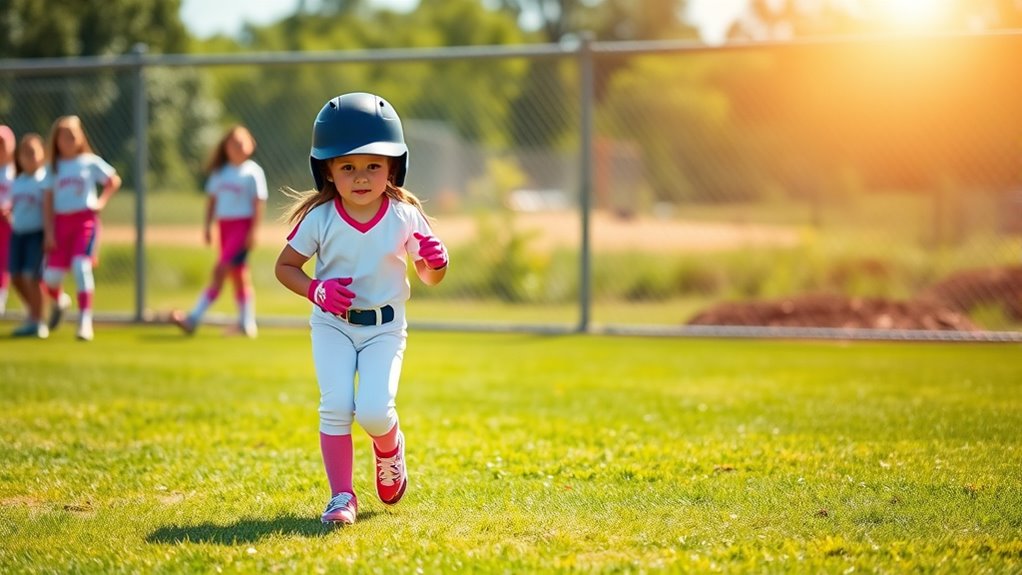To step onto the field confidently, start by ensuring you have the right equipment, like a glove, helmet, and cleats, and learn basic skills such as throwing, catching, and batting. Focus on proper technique and safety, practicing drills to build accuracy, muscle memory, and agility. Approach each session gradually, progressing to more complex scenarios. Keep practicing consistently, and as you do, you’ll uncover more tips to improve your game every step of the way.
Key Takeaways
- Ensure proper equipment: glove, bat, cleats, and helmet for safety and comfort.
- Start with foundational drills: catching, throwing, and proper grip to build accuracy and muscle memory.
- Practice hitting with tees and soft toss to develop timing and consistent contact.
- Work on fielding ground balls using cones or partners to improve agility and glove skills.
- Progress gradually to more complex drills and game scenarios, emphasizing safety and technique.

Getting started with softball can be both exciting and intimidating, but with the right basics, you’ll quickly gain confidence on the field. The first step is understanding the essential equipment essentials. You’ll need a good pair of softball gloves that fit comfortably, a reliable bat suited for your size and strength, and softball-specific cleats for proper traction. Don’t forget a helmet with a faceguard for safety, and some practice balls to get comfortable with hitting and catching. Having the right gear not only keeps you safe but also boosts your confidence during practice and games.
Getting the right equipment boosts your confidence and keeps you safe on the softball field.
Once you’ve gathered your equipment essentials, it’s time to focus on training drills that build foundational skills. Starting with simple drills like catching and throwing helps develop accuracy and hand-eye coordination. Practice catching fly balls by tossing them softly into the air and catching them with your glove, gradually increasing the difficulty as you improve. For throwing, work on proper grip and arm motion by practicing quick, controlled throws to a partner or a designated target. These drills are essential for developing the muscle memory needed during games.
Hitting is another indispensable skill, and you can start with basic batting drills. Use a tee to practice proper stance, grip, and swing path, ensuring you make consistent contact with the ball. As you get more comfortable, incorporate soft toss drills where a partner gently tosses balls for you to hit, helping you develop timing and hand-eye coordination. Remember, consistency is key, so focus on proper technique rather than power early on.
Fielding ground balls is just as important. Set up cones or use a partner to roll balls toward you, practicing quick footwork and glove placement. Always keep your knees bent and stay low to get underneath the ball. Repetition helps build agility and confidence in your ability to handle different types of hits.
Additionally, understanding the importance of high-quality equipment like home theater projectors can make your practice sessions more enjoyable by creating a motivating environment. Throughout your early training, prioritize safety and proper technique. Don’t rush through drills—focus on doing each one correctly. As you progress, gradually challenge yourself with more complex drills and game scenarios. With consistent practice, you’ll see improvements in your skills, making the game more enjoyable and less intimidating. Remember, everyone starts somewhere, and every catch, throw, or hit is a step forward. Embrace the learning process, stay dedicated, and most importantly, have fun on the field.
Frequently Asked Questions
What Is the Optimal Size for a Softball Field?
When considering the ideal size for a softball field, you should focus on standard field dimensions and safety zones. Typically, the distance from home plate to the outfield fence ranges from 200 to 250 feet, depending on age and league level. A proper safety zone around the bases and pitcher’s mound helps prevent injuries. Ensuring these dimensions and zones are correctly set promotes a safe, enjoyable playing environment for all players.
How Do I Choose the Right Softball Gear?
When choosing the right softball gear, prioritize protective equipment like a helmet, face guard, and sliding shorts to stay safe. Look for well-fitting softball accessories such as gloves, cleats, and batters’ gear that match your size and comfort. Always opt for quality gear that offers durability and protection, ensuring you feel confident and secure on the field. Remember, the right equipment boosts your performance and keeps you safe during play.
What Are Common Mistakes Beginners Make?
You might think you’re perfect at the game, but beginners often make the mistake of ignoring player positioning and coaching tips. You could be standing in the wrong spot or missing key advice that could change the game. Focus on proper positioning and listen carefully to coaching tips, instead of rushing or overthinking. This helps you stay prepared, reduce errors, and boost your confidence on the field.
How Do I Improve My Batting Skills?
To improve your batting skills, focus on your batting stance and swing mechanics. Keep your feet shoulder-width apart, stay balanced, and position your hands comfortably. Practice smooth, controlled swings, ensuring you rotate your hips and follow through properly. Regular drills help build muscle memory, and watching experienced players can give you tips. Consistent practice and paying attention to your stance and swing mechanics will boost your confidence and accuracy at the plate.
What Are Basic Rules for Running Bases?
To master running bases, focus on base running fundamentals like staying alert and running efficiently. Always watch the ball and your teammates’ signals before advancing. Practice base stealing techniques by timing your start with the pitcher’s release and sliding safely into the base. Keep your head up, avoid unnecessary tags, and stay aggressive but controlled. Improving these skills boosts your confidence and helps you become a more effective player on the field.
Conclusion
Now that you’ve got the basics down, you’re ready to step onto the field with confidence. Remember, every legendary player started as a beginner, just like you. Embrace the learning curve, stay positive, and enjoy the game. Whether you’re swinging a bat or catching a pop-up, you’re part of a team. So, channel your inner Babe Ruth, and don’t be afraid to make mistakes—they’re just part of your epic softball journey ahead!









